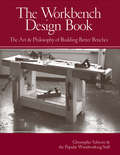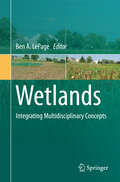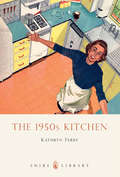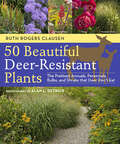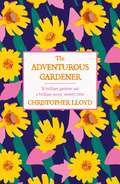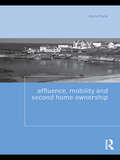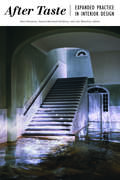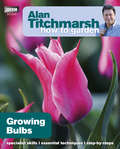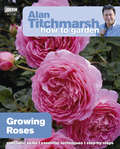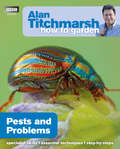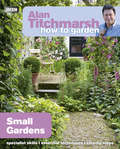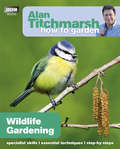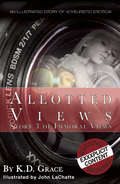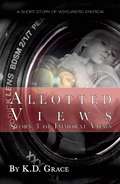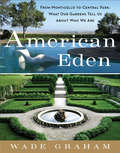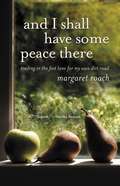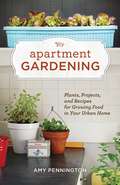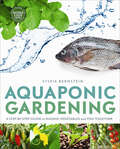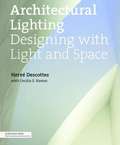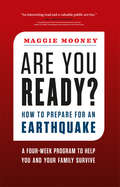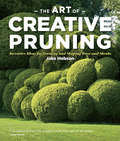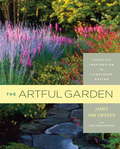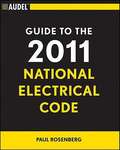- Table View
- List View
The Workbench Design Book: The Art & Philosophy of Building Better Benches
by Christopher SchwarzThe follow-up book to Workbenches: From Design & Theory to Construction & UseComplete plans, expert instruction and rationale for building nine workbench formsInstruction on improving existing workbenches for better workholding and an improved woodworking shop.The Workbench Design Book not only shows how to design a workbench--it also discusses and presents nine specific designs plus critiques of 10 additional workbenches, with suggestions for making any bench work most effectively for the kind of work the user does. The 9 workbench plans have a range suitable for all workshop needs, from handwork to power tools. A discussion of workbench design rules teach what's effective and why in a multitude of workshop situations. Additional workholding options--from shop-made jigs and commercial bench dogs to vise hardware--are also provided.
Wetlands
by Ben A. LepageThe science of wetlands and our understanding of these complex ecosystems have improved considerably. The emergence of multidisciplinary strategies is providing new opportunities and innovative approaches to address issues such as climate change and coastal protection. This book, with contributions from 19 specialists from academia, government, and industry, provides a trans-disciplinary approach to the understanding wetlands science, drawing together a wide range of expertise. Topics covered include the physical aspects that shape different wetlands around the world, as well as wetlands ecology, regulation, policy, and related social and economic issues. Featuring contributions from some of the world's leading wetlands researchers and practitioners, this book provides an invaluable resource for undergraduate and post-graduate training in all aspects of wetlands management, conservation, and construction. It is also a useful auxiliary text for researchers working across disciplines in fields such as wetlands science, law, landscape architecture, environmental engineering, conservation ecology, and related disciplines.
150 Best New Apartment Ideas
by Francesc Zamora MolaThis information-packed volume explores the manifold ways in which architects and designers meet the various challenges of designing and decorating apartments for their clients. Featuring an extensive collection of apartments from around the world, 150 Best New Apartment Ideas provides an in-depth look at the most stunning, innovative, and practical design solutions working today. Covering a wealth of information and showcasing the latest design trends, this little book is an inspirational source of ideas, perfect for the homeowner and the professional alike.
The 1950s Kitchen
by Kathryn FerryThe 1950s was the first great age of the modern kitchen: labor-saving appliances, bright colors and the novelty of fitted units moved the kitchen from dankness into light, where it became the domain of the happy housewife and the heart of the home. Formica - a new space-age material - decorated with fashionable patterns topped sleek cupboards that contained new classic wares such as Pyrex and 'Homemaker' crockery, and the ingredients for 1950s British staples: semolina, coronation chicken and spotted dick. Electricity entered the kitchens of millions, and nowhere in the home was modern technology and modern design more evident. Bold color, clean lines and stainless steel were keynotes of the decade, and it is no surprise that 1950s kitchen style is now the height of fashion once again, with names like Cath Kidston picking up on the best of '50s kitchen kitsch, and manufacturers like Dualit, Kitchen Aid and Aga doing healthy business with retro appliances. This book - a celebration of cooking, eating and living in the 1950s kitchen - is a feast of nostalgia, and a mine of inspiration for anyone wanting to recreate that '50s look in their own home.From the Trade Paperback edition.
50 Beautiful Deer-Resistant Plants: The Prettiest Annuals, Perennials, Bulbs, and Shrubs that Deer Don't Eat
by Alan L. Detrick Ruth Rogers ClausenKeeping your beautiful garden safe from deer is as simple as choosing the right plants. Are deer destroying your garden? There is a solution, and it doesn’t involve fencing, barriers, or chemicals. In 50 Beautiful Deer-Resistant Plants perennial expert Ruth Rogers Clausen highlights the best, most versatile plants that deer simply don’t eat. The plant choices include annuals and perennials, shrubs, ferns, bulbs, grasses, and herbs; for each Clausen shares helpful growing and design tips. This practical, authoritative, full-color guide is a must-have solution to a must-stop problem.
Advances in Physical Ergonomics and Human Factors: Proceedings of the AHFE 2016 International Conference on Physical Ergonomics and Human Factors, July 27-31, 2016, Walt Disney World®, Florida, USA (Advances in Intelligent Systems and Computing #489)
by Ravindra Goonetilleke Waldemar KarwowskiTaking the field of human factors and ergonomics beyond state of the art, this volume focuses on advances in the use of ergonomics modeling and on the evaluation of usability, which is a critical aspect of any human-technology system. The research described in the book's 70 chapters is an outcome of dedicated research by academics and practitioners from around the world, and across disciplines. The chapters are organized under five sections: I. Models and Methods II. Vision and Visual Displays , III. Product Design and User Interfaces IV. Input Devices and Computer Based Systems V. Individual and Environmental Technology Related Issues. This work provides an invaluable resource for evaluating products and environments and designing future ones that are intuitive, safe, and easy to use. Seven other titles in the Advances in Human Factors and Ergonomics Series are: Advances in Human Factors and Ergonomics in Healthcare Advances in Applied Digital Human Modeling Advances in Cross-Cultural Decision Making Advances in Cognitive Ergonomics Advances in Occupational, Social and Organizational Ergonomics Advances in Human Factors, Ergonomics and Safety in Manufacturing and Service Industries Advances in Neuroergonomics and Human Factors of Special Populations
The Adventurous Gardener
by Christopher Lloyd'The best informed, liveliest and most innovative gardening writer of our times' GUARDIAN'Christopher Lloyd ranks with Gertrude Jekyll and Vita Sackville-West as one of the major figures in twentieth-century British gardening' THE TIMESIn this gardening classic the forever adventurous Christopher Lloyd takes us on a tour through the garden, to encourage, to reveal and to overturn the old and accepted when experience prompts him. He advises on cuttings, pruning, the art of compromise and takes another look at Miss Jekyll. Gardening was a passion, and throughout his life he developed Great Dixter to be one of Britain's greatest gardens. For Christo gardening is nothing if not fun and - pointing out that 'to be roused into an argumentative frame of mind is in itself no bad thing' - he makes it equally stimulating and enjoyable for his readers.
Affluence, Mobility and Second Home Ownership (Housing and Society Series)
by Chris ParisDespite the current recession, the frequency of second home ownership is still surprisingly high throughout the western world. While the UK and Ireland previously had lower occurrences of multiple dwellings compared to the rest of Europe, they are quickly catching up with a current surge in the ownership of second homes. The recent MP expenses scandal in the UK has also drawn attention to the prevalence of second homes (or more) within the middle classes, and the fact that the concept is becoming increasingly popular. Chris Paris uses this text to address the reasons behind why second homes are becoming more popular, both within the usual domicile of the individuals, and in international locations. The socioeconomic factors and historical contexts of homes in cultures across the world are fundamental to explaining the choices in transnational home ownership, and Paris’ case studies and comparisons between additional homes in Europe, Australia, America and Asia expand upon the motivation for people to own a second home. Affluence, Mobility and Second Home Ownership draws together debates on gentrification, globalisation, consumerism, environmental factors and investment to provide a balanced look at the pros, and cons, of second home ownership, and what implications it has for the future. An ideal text for students studying geography, urbanism and planning, this book is also of interest to individuals interested in the changing ways in which we make choices on our places of residence.
After Taste: Expanded Practice in Interior Design
by Lois Weinthal Joanna Merwood-Salisbury Kent KleinmanWhat is taste? This well-curated collection documents new theories and emerging critical practices in the field of interior design. It investigates taste, a concept central to the formation of the discipline in the eighteenth century that was repudiated by architects in the early twentieth century, but which continues to play an important role in interior design today. Essays by historians and critics are complemented by interviews with practitioners on the margins of normative practice and portfolios of the work of contemporary designers.
Alan Titchmarsh How to Garden: Growing Roses (How to Garden #8)
by Alan TitchmarshThe rose is the nation's favourite flower and never goes out of fashion. In this definitive guide, Alan Titchmarsh shows how to grow and care for roses in your garden. He covers all the essential techniques and provides inspirational ideas for training and planting schemes that will ensure healthy plants and stunning displays year on year.* A-Z directory of Alan's recommended roses* Essential techniques for pruning and support* How to combine roses with other plants* Suggested roses for all garden situations, including shady and exposed sites* Comprehensive guide to understanding rose types
Alan Titchmarsh How to Garden: Pests and Problems (How to Garden #26)
by Alan TitchmarshIn this definitive guide, Alan Titchmarsh addresses key problem areas and provides easy-to-follow guidance on how to protect precious plants. Encouraging gardeners to create healthy ecosystems, Alan talks through the techniques to deal with harmful pests, weeds, diseases and disorders and suggests preventative measures to ensure happy, disease-resistant plants.* Directory of pests and problems with over 200 colour illustrations* Good gardening techniques for preventing disorders* How to select the right plants for the right conditions* Advice on chemical versus nonchemical treatments* Instructions for tackling problems in lawns and borders
Alan Titchmarsh How to Garden: Small Gardens (How to Garden #11)
by Alan TitchmarshSuccessful gardens can be created in the smallest spaces, and in this inspiring and practical guide Alan Titchmarsh shows how to transform even the tiniest outdoor area into an attractive garden. With ideas for maximizing space and advice on garden design, planning and plant selection, this is the definitive handbook for anyone wanting to create a private haven in limited space.* Ideas for front gardens, side passages, courtyards, balconies, rooftops and windowsills* Tricks to make small spaces seem larger* How to use every inch of space, including containers* Easy-to-follow landscaping plans for all garden shapes and styles* Guidance on growing vegetables, herbs and fruit in small plots
Alan Titchmarsh How to Garden: Wildlife Gardening (How to Garden #12)
by Alan TitchmarshThe most successful gardens work with nature to create natural environments in which jobs such as pollination and pest control are left to the wildlife. In this definitive guide, Alan Titchmarsh shows how to create natural ecosystems in your garden to encourage beneficial insects, birds and other wildlife and establish the best environment in which your garden will thrive.* Design ideas and planting plans for wildlife-friendly gardens* Wildlife gallery showing common birds, mammals, amphibians and insects and how to attract them to your garden* How to create natural habitats * Recommended trees, shrubs and flowers for biodiversity* Seasonal tasks for the year
Allotted Views
by K. D. Grace John LachatteIn Allotted Views by K.D. Grace a nosey gardener is treated to a raunchy ritual through her bedroom window. Illustrated versions illustrated by John LaChatte.
Allotted Views
by K. D. GraceIn Allotted Views by K.D. Grace a nosey gardener is treated to a raunchy ritual through her bedroom window.
American Eden: From Monticello to Central Park to Our Backyards
by Wade GrahamThe story of our nation and ourselves as told through our country's most significant gardens and their creators. From Frederick Law Olmsted to Richard Neutra, Michelle Obama to our neighbors, Americans throughout history have revealed something of themselves--their personalities, desires, and beliefs--in the gardens they create. Rooted in the time and place of their making, as much as in the minds and identities of their makers, gardens mirror the struggles and energies of a changing society. Melding biography, history, and cultural commentary in a one-of-a-kind narrative, American Eden presents a dynamic, sweeping look at this country's landscapes and the visionaries behind them. Monticello's gardens helped Jefferson reconcile his conflicted feelings about slavery-and take his mind off his increasing debt. Edith Wharton's gardens made her feel more European and superior to her wealthy but insufficiently sophisticated countrymen. Martha Stewart's how-to instructions helped bring Americans back into their gardens, while at the same time stoking and exploiting our anxieties about social class. Isamu Noguchi's and Robert Smithson's experiments reinvigorated the age-old exchange between art and the garden. American Eden offers an inclusive definition of the garden, considering intentional landscapes that range from domestic kitchen gardens to city parks and national parks, suburban backyards and golf courses, public plazas and Manhattan's High Line park, reclaimed from freight train tracks. And it exposes the overlap between garden-making and painting, literature, and especially architecture-the garden's inseparable sibling-to reveal the deep interconnections between the arts and their most inspired practitioners. Moving deftly through time and place across America's diverse landscapes--from Revolutionary-era Virginia to turn-of-the-century Chicago to 1960s suburban California--and featuring a diverse cast of landscape-makers--whether artists, architects, or housewives, amateurs or professionals, robber barons, politicians, reformers, or dreamers--Wade Graham vividly unfolds the larger cultural history through more personal dramas. Beautifully illustrated with color and black-and-white images, American Eden is at once a different kind of garden book and a different kind of American history, one that offers a compelling, untold story--a saga that mirrors and illuminates our nation's invention, and constant reinvention, of itself.
And I Shall Have Some Peace There: Trading in the Fast Lane for My Own Dirt Road
by Margaret RoachThis e-book includes 26 bonus photos from the author!Margaret Roach worked at Martha Stewart Living Omnimedia for 15 years, serving as Editorial Director for the last 6. She first made her name in gardening, writing a classic gardening book among other things. She now has a hugely popular gardening blog, "A Way to Garden." But despite the financial and professional rewards of her job, Margaret felt unfulfilled. So she moved to her weekend house upstate in an effort to lead a more authentic life by connecting with her garden and with nature. The memoir she wrote about this journey is funny, quirky, humble--and uplifting--an Eat, Pray, Love without the travel-and allows readers to live out the fantasy of quitting the rat race and getting away from it all.
Apartment Gardening: Plants, Projects, and Recipes for Growing Food in Your Urban Home
by Amy PenningtonForget the 100-mile eat-local diet; try the 300-square-foot-diet -- grow squash on the windowsill, flowers in the planter box, or corn in a parking strip. Apartment Gardening details how to start a garden in the heart of the city. From building a window box to planting seeds in jars on the counter, every space is plantable, and this book reveals that the DIY future is now by providing hands-on, accessible advice. Amy Pennington's friendly voice paired with Kate Bingham-Burt's crafty illustrations make greener living an accessible reality, even if readers have only a few hundred square feet and two windowsills. Save money by planting the same things available at the grocery store, and create an eccentric garden right in the heart of any living space.
Aquaponic Gardening: A Step-by-Step Guide to Raising Vegetables and Fish Together (Mother Earth News Books for Wiser Living)
by Sylvia Bernstein&“I have always wanted to figure out how to do sustainable aquaculture in the context of my home garden. Finally I&’ve got the book to help me do it.&” —Paul Greenberg, New York Times–bestselling author, Four Fish: The Future of the Last Wild Food Aquaponics is a revolutionary system for growing plants by fertilizing them with the waste water from fish in a sustainable closed system. A combination of the best of aquaculture and hydroponics, aquaponic gardening is an amazingly productive way to grow organic vegetables, greens, herbs and fruits, while providing the added benefits of fresh fish as a safe, healthy source of protein. On a larger scale, it is a key solution to mitigating food insecurity, climate change, groundwater pollution and the impacts of overfishing on our oceans.Aquaponic Gardening is the definitive do-it-yourself home manual, focused on giving you all the tools you need to create your own aquaponic system and enjoy healthy, safe, fresh and delicious food all year round. Starting with an overview of the theory, benefits and potential of aquaponics, the book goes on to explain: System location considerations and hardware components The living elements—fish, plants, bacteria, and worms Putting it all together—starting and maintaining a healthy system. Aquaponics systems are completely organic. They are four to six times more productive and use 90 percent less water than conventional gardens. Other advantages include no weeds, fewer pests, and no watering, fertilizing, bending, digging, or heavy lifting—in fact, there really is no down side! Anyone interested in taking the next step towards self-sufficiency will be fascinated by this practical, accessible and well-illustrated guide. &“An excellent primer for anyone considering home-scale aquaculture.&” —Peter Bane, publisher, Permaculture Activist and author, The Permaculture Handbook
Architectural Lighting
by Hervé Descottes Cecilia E. RamosArchitectural Lighting, the latest addition to the Architecture Briefs series, provides both a critical approach to and a conceptual framework for understanding the application of lighting in the built environment. The key considerations of lighting design are illuminated through accessible texts and instructional diagrams. Six built projects provide readers with concrete examples of the ways in which these principles are applied. Short essays by architect Steven Holl, artist Sylvain Dubuisson, and landscape architect James Corner explore the role of lighting in defining spatial compositions.
Are You Ready?
by Maggie MooneyAs earthquakes have struck around the world with alarming frequency, millions have realized they are unprepared for similar catastrophes close to home. Online disaster plans and older books-heavy with seismic science and a survivalist focus-leave the average reader overwhelmed with details and anxiety. How much water will I need? What if I'm driving? How do I protect my six-year-old? The questions go on-and in this book Maggie Mooney answers them. Her four-week readiness program includes straightforward instructions, forms, and checklists. Mooney explains what to expect during a quake, and what to do when the shaking stops. She also addresses both aftershocks and tsunamis.Use this guide and the checklists inside to get ready:Find your safe spots at home, at work, at school, and outdoors.Develop your emergency communication plan.Shake-proof your home.Assemble emergency supplies. By following the steps in the four-week readiness program described here you can avoid injury and ensure you have the food, water and other essentials you need to be prepared rather than scared.
The Art of Creative Pruning: Inventive Ideas for Training and Shaping Trees and Shrubs
by Jake HobsonNothing brings a touch of artistry to the garden like ornamental pruning, and a series of deliberate cuts can create landscapes and evoke faraway places. All that's needed to recreate the effect in the garden are a sharp pair of pruners, some imagination, and the instruction found in The Art of Creative Pruning. Drawing on both eastern and western styles, author Jake Hobson moves beyond the traditional lollipops and animals and teaches a wholly new approach to ornamental pruning that appeals to modern sensibilities. Picture boxwoods trimmed into whimsical Russian nesting dolls, hedges inscribed with words, and a tree snipped to resemble the toppling tiers of a wedding cake. These are just a few of the unusual ideas featured in the beautifully photographed pages. All the practical considerations are here as well, including pruning to improve a view, remedial pruning to fix problems, and pruning fruit trees to increase yield.
The Artful Garden
by James Van Sweden Tom Christopher#x1C;I want to put the mystery back into the heart of garden design, where it needs to be. It#x19;s what lures you in through the gate, keeps you moving through the landscape, and fills you with excitement along the way. The sense of mystery is what turns a mere display of plants, paths, and ornaments into an adventure. #x1D; -James van Sweden Guided by world-renowned landscape architect James van Sweden and horticulture expert Tom Christopher, any gardener can learn the secrets of the gardener#x19;s art and absorb the essence of inspired garden design. In their gifted hands, creating your own perfect garden, with its own alluring mysteries, turns out to be not only easy but a delight. Whether it#x19;s a ten-foot-square city terrace or a ten-acre expanse, the same principles apply: the intelligent use of positive and negative space, of form and scale, of light and shadow, of rough and smooth textures. Do you want a garden you can immerse yourself in? A garden you can smell and listen to as well as observe? An exuberant garden or a contemplative garden? In this elegantly written and visually stunning book, van Sweden reveals the secrets of famous gardens around the world and encourages you to find inspiration in the arts-in painting (from America#x19;s classic regional artists to the abstract expressionists), music (from classical to jazz), sculpture, even dance. He introduces you to famous artists who share how their art has influenced the design of their own gardens, and teaches you to think not in terms of borders and beds or even paths and meadows but of a tapestry woven from sky, trees, rocks, vines, flowers, grasses, and space. Richly illustrated throughout with magnificent photographs,The Artful Gardenboth tells and shows, sharing with beginning and experienced gardeners a wealth of inspiration and practical help. #x1C;What#x19;s my message?#x1D; van Sweden asks in conclusion. The wise answer: #x1C;Don#x19;t squander the potential for surprise and wonder. #x1D;This beautiful book guarantees everyone who reads it a priceless store of gardening wisdom.
Audel Guide to the 2011 National Electrical Code
by Paul RosenbergThe NEC is updated every 3 years with some of the anticipated changes include new requirements to sections while some of the changes include entirely new articles. Some changes are revisions to existing requirements while others are deletions to some existing requirements. As with the last edition of this book the author will use an icon or other graphical feature to highlight all changes to the 2011 code from the 2008 version. The book is considered an easy reference tool for those individuals on the job in need of a handy reference without the bulk and formality of the code itself. Significant changes to wiring and protection sections as well as new coverae of hybrid electric vehicles and small wind turbine power generators are being made. As always there will be numerous small changes made throughout the book. In short if a change has been made to the code it will be covered in this book in an easy to read instructional way.
